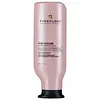What's inside
What's inside
 Key Ingredients
Key Ingredients

No key ingredients
 Benefits
Benefits

 Concerns
Concerns

 Ingredients Side-by-side
Ingredients Side-by-side

Water
Skin ConditioningCetyl Alcohol
EmollientDidecyldimonium Chloride
EmulsifyingPolyquaternium-37
Panthenol
Skin ConditioningHedychium Coronarium Flower/Leaf/Stem Extract
Skin ConditioningRosmarinus Officinalis Leaf Extract
AntimicrobialAnthemis Nobilis Flower Extract
MaskingAloe Barbadensis Leaf Extract
EmollientSimmondsia Chinensis Leaf Extract
HumectantAlgae Extract
EmollientWheat Amino Acids
Skin ConditioningHydrolyzed Wheat Protein
Skin ConditioningHydrolyzed Wheat Starch
Skin ConditioningHydrolyzed Wheat Protein Pg-Propyl Silanetriol
Skin ConditioningCocodimonium Hydroxypropyl Hydrolyzed Rice Protein
Skin ConditioningCetrimonium Chloride
AntimicrobialIsopropyl Alcohol
SolventPropylene Glycol Dicaprylate/Dicaprate
EmollientPPG-1 Trideceth-6
Skin ConditioningMagnesium Nitrate
Bisamino PEG/PPG-41/3 Aminoethyl Pg-Propyl Dimethicone
Methylchloroisothiazolinone
PreservativeMagnesium Chloride
Potassium Sorbate
PreservativePhenoxyethanol
PreservativePEG-12 Dimethicone
Skin ConditioningMethylisothiazolinone
PreservativeParfum
MaskingBenzyl Benzoate
AntimicrobialBenzyl Alcohol
PerfumingSodium Benzoate
MaskingWater, Cetyl Alcohol, Didecyldimonium Chloride, Polyquaternium-37, Panthenol, Hedychium Coronarium Flower/Leaf/Stem Extract, Rosmarinus Officinalis Leaf Extract, Anthemis Nobilis Flower Extract, Aloe Barbadensis Leaf Extract, Simmondsia Chinensis Leaf Extract, Algae Extract, Wheat Amino Acids, Hydrolyzed Wheat Protein, Hydrolyzed Wheat Starch, Hydrolyzed Wheat Protein Pg-Propyl Silanetriol, Cocodimonium Hydroxypropyl Hydrolyzed Rice Protein, Cetrimonium Chloride, Isopropyl Alcohol, Propylene Glycol Dicaprylate/Dicaprate, PPG-1 Trideceth-6, Magnesium Nitrate, Bisamino PEG/PPG-41/3 Aminoethyl Pg-Propyl Dimethicone, Methylchloroisothiazolinone, Magnesium Chloride, Potassium Sorbate, Phenoxyethanol, PEG-12 Dimethicone, Methylisothiazolinone, Parfum, Benzyl Benzoate, Benzyl Alcohol, Sodium Benzoate
Water
Skin ConditioningCetearyl Alcohol
EmollientBehentrimonium Chloride
PreservativeCetyl Esters
EmollientIsopropyl Myristate
EmollientIsopropyl Alcohol
SolventPhenoxyethanol
PreservativeParfum
MaskingPolyquaternium-37
Propylene Glycol Dicaprylate/Dicaprate
EmollientTocopherol
AntioxidantGlycerin
HumectantButylene Glycol
HumectantPPG-1 Trideceth-6
Skin ConditioningChlorhexidine Dihydrochloride
AntimicrobialHydroxypropyltrimonium Hydrolyzed Wheat Protein
Skin ConditioningHelianthus Annuus Seed Extract
Skin ConditioningWheat Amino Acids
Skin ConditioningHydrolyzed Vegetable Protein Pg-Propyl Silanetriol
Skin ConditioningSodium Chloride
MaskingSorbitan Oleate
EmulsifyingBenzophenone-4
UV AbsorberCitric Acid
BufferingLimonene
PerfumingEucalyptus Globulus Leaf Extract
PerfumingAscorbic Acid
AntioxidantPotassium Sorbate
PreservativeDisodium EDTA
Water, Cetearyl Alcohol, Behentrimonium Chloride, Cetyl Esters, Isopropyl Myristate, Isopropyl Alcohol, Phenoxyethanol, Parfum, Polyquaternium-37, Propylene Glycol Dicaprylate/Dicaprate, Tocopherol, Glycerin, Butylene Glycol, PPG-1 Trideceth-6, Chlorhexidine Dihydrochloride, Hydroxypropyltrimonium Hydrolyzed Wheat Protein, Helianthus Annuus Seed Extract, Wheat Amino Acids, Hydrolyzed Vegetable Protein Pg-Propyl Silanetriol, Sodium Chloride, Sorbitan Oleate, Benzophenone-4, Citric Acid, Limonene, Eucalyptus Globulus Leaf Extract, Ascorbic Acid, Potassium Sorbate, Disodium EDTA
Ingredients Explained
These ingredients are found in both products.
Ingredients higher up in an ingredient list are typically present in a larger amount.
Isopropyl Alcohol is more commonly known as rubbing alcohol. It is most commonly used as a solvent, meaning it helps other ingredients dissolve.
This ingredient is an astringent alcohol. Astringent alcohols may also irritate skin as they high amounts may strip away your skin's natural oils.
Other types of astringent alcohols include:
According to the National Rosacea Society based in the US, you should be mindful of products with these alcohols in the top half of ingredients.
Any type of sanitizing product will have high amounts of alcohol to help kill bacteria and viruses.
Learn more about Isopropyl AlcoholParfum is a catch-all term for an ingredient or more that is used to give a scent to products.
Also called "fragrance", this ingredient can be a blend of hundreds of chemicals or plant oils. This means every product with "fragrance" or "parfum" in the ingredients list is a different mixture.
For instance, Habanolide is a proprietary trade name for a specific aroma chemical. When used as a fragrance ingredient in cosmetics, most aroma chemicals fall under the broad labeling category of “FRAGRANCE” or “PARFUM” according to EU and US regulations.
The term 'parfum' or 'fragrance' is not regulated in many countries. In many cases, it is up to the brand to define this term.
For instance, many brands choose to label themselves as "fragrance-free" because they are not using synthetic fragrances. However, their products may still contain ingredients such as essential oils that are considered a fragrance by INCI standards.
One example is Calendula flower extract. Calendula is an essential oil that still imparts a scent or 'fragrance'.
Depending on the blend, the ingredients in the mixture can cause allergies and sensitivities on the skin. Some ingredients that are known EU allergens include linalool and citronellol.
Parfum can also be used to mask or cover an unpleasant scent.
The bottom line is: not all fragrances/parfum/ingredients are created equally. If you are worried about fragrances, we recommend taking a closer look at an ingredient. And of course, we always recommend speaking with a professional.
Learn more about ParfumPhenoxyethanol is a preservative that has germicide, antimicrobial, and aromatic properties. Studies show that phenoxyethanol can prevent microbial growth. By itself, it has a scent that is similar to that of a rose.
It's often used in formulations along with Caprylyl Glycol to preserve the shelf life of products.
We don't have a description for Polyquaternium-37 yet.
Potassium Sorbate is a preservative used to prevent yeast and mold in products. It is commonly found in both cosmetic and food products.
This ingredient comes from potassium salt derived from sorbic acid. Sorbic acid is a natural antibiotic and effective against fungus.
Both potassium sorbate and sorbic acid can be found in baked goods, cheeses, dried meats, dried fruit, ice cream, pickles, wine, yogurt, and more.
You'll often find this ingredient used with other preservatives.
Learn more about Potassium SorbateWe don't have a description for PPG-1 Trideceth-6 yet.
Propylene Glycol Dicaprylate/Dicaprate is a mixture of Propylene Glycol Dicaprylate and Propylene Glycol Dicaprate.
It is an emollient and helps hydate the skin.
Water. It's the most common cosmetic ingredient of all. You'll usually see it at the top of ingredient lists, meaning that it makes up the largest part of the product.
So why is it so popular? Water most often acts as a solvent - this means that it helps dissolve other ingredients into the formulation.
You'll also recognize water as that liquid we all need to stay alive. If you see this, drink a glass of water. Stay hydrated!
Learn more about WaterWe don't have a description for Wheat Amino Acids yet.